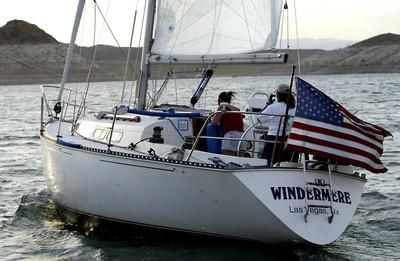ADVENTURE BECKONS: Racing the Wind and Waves

The tension builds on board the Windermere as Kim Lighthart, sailboat captain, zigs and zags toward the finish line for the second race of the day.
The late afternoon sun is unmerciful out on the open water but the wind is high, a Lake Mead sailor’s dream. Lighthart looks up at the sails — pregnant with the wind — then scans the horizon for her competition.
“We will be the first to cross the line,” she announces to her crew of two, Michelle Gober and Alix Reed.
“Do we need to bring it over?” Reed asks, referring to the main sail.
The sailboat is about 30 seconds away from the finish of the second heat of the Nevada Yacht Club’s Women’s Regatta at Lake Mead on a recent Saturday. The Windermere is one of five sailboats, all manned by women, bearing down on the finish line buoy and a crack at bragging rights once all four individual races are finished. A few motorboats anchored nearby hold some of the male members of the yacht club who are there to watch and later learn to stay off the radio, at least while the women race.
“I think we’re good. What do you think? What does everybody think?” Lighthart answers and they all agree to stay the course. “We are so lovely right now, ladies.”
To prove her point, the horn sounds as the Windermere crosses the finish and the women cheer with delight.
Suddenly, the baritone voices of male sailboat watchers crackle over the radio, hinting at what they would do approaching the finish line. Four sailboats have yet to cross and any of them might benefit from the seemingly casual talk. But men are banned during the women’s regattas; help from them results in a penalty against the women receiving it.
“Why don’t you guys get off the radio?” a female voice barks back at them, silencing their chatter.
The club, which has been around since the 1960s, hosts an event at least once a month, says the club’s fleet captain and race officer, David Hoch. A women’s regatta takes place four times a year. After each race, a plaque or trophy is awarded. Members get together every Wednesday and Saturday for unofficial races, too.
The club boasts about 60 members from all walks of life: Realtors, retirees, bankers, government employees, health workers. But water is a great equalizer: Though they come from different backgrounds, they’re all alike when they’re tacking a sail or working a winch.
“It’s purely for fun. We just love to sail and love to race,” Hoch says.
Most people join the club to become better sailors, he adds, and in order to do that, one must race.
About six years ago, member Joyce Smith started the women’s regattas to give the female sailors a chance to sharpen their skills independently of the guys. Each boat can be crewed only by women, although some husbands and significant others try to help out via the radio.
“That’s the hard thing about women’s racing. We start a race and a bunch of guys on this little boat start yelling, ‘Sheet in, sheet in!’ They start on the cell phones and the radio. We have to turn the radio off,” Smith says.
Apparently that is but one of the differences between the sexes when it comes to sailing.
“Women sail by consensus, men by chain of command,” Lighthart explains as she points the boat toward the start line and the third race.
They must pick up enough wind speed to get them to the right place at the right time. A slight misjudgment and they could be too late or start the race before it starts, never a good thing, Lighthart adds.
A crew member for four years, Lighthart started captaining her own boat a year ago. Today, she’s sailing a friend’s boat because it’s faster than her own. She races every chance she gets. Lighthart got hooked on sailing a few years ago when she invited herself on a friend’s vacation; they chartered a boat and sailed to Catalina Island.
“I ended up loving sailing. It’s peaceful. Very, very peaceful,” she says amid a frenzy of flying rope, popping sails and scurrying crew. They’re minutes into the third race, losing speed and position because of a knot in the main sail line. Gober works frantically to undo it but before she can finish, Lighthart warns: “We’ve got to tack or I’m going to hit Bombardier.” Tacking refers to switching the main sail from left to right, or vice versa.
The sailboat was fast approaching starboard side and impact seemed imminent until Lighthart decided to “dip” them, turning the wheel sharply and averting disaster. Dipping another boat steals a bit of their wind, slowing them down. The move helped put Windermere in better position.
“Now, let’s go chase them down.”
Yes, sailing is peaceful.